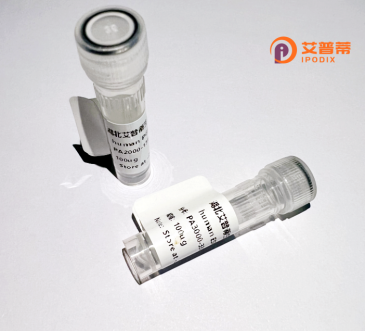
| 纯度 | >90%SDS-PAGE. |
| 种属 | Human |
| 靶点 | FLJ23834 |
| Uniprot No | Q6ZTQ4 |
| 内毒素 | < 0.01EU/μg |
| 表达宿主 | E.coli |
| 表达区间 | 776-885aa |
| 氨基酸序列 | IFDGEAIDPVTGETYEFNSKTGARKWKDPLTQMPKWKESSHQGAAPRRVTAGEGMGSLRSANWEEDELSGKAWAEDAGLGSRNEGGKLGNPKNRNPAFMNRAYPKPHPGK |
| 分子量 | 37.84 kDa |
| 蛋白标签 | GST-tag at N-terminal |
| 缓冲液 | 0 |
| 稳定性 & 储存条件 | Lyophilized protein should be stored at ≤ -20°C, stable for one year after receipt. Reconstituted protein solution can be stored at 2-8°C for 2-7 days. Aliquots of reconstituted samples are stable at ≤ -20°C for 3 months. |
| 复溶 | Always centrifuge tubes before opening.Do not mix by vortex or pipetting. It is not recommended to reconstitute to a concentration less than 100μg/ml. Dissolve the lyophilized protein in distilled water. Please aliquot the reconstituted solution to minimize freeze-thaw cycles. |
以下是几篇可能与重组人FLJ23834蛋白相关的研究文献示例(注:FLJ23834为基因临时编号,实际研究中可能使用其他名称,建议结合具体基因功能验证):
---
1. **文献名称**: _Characterization of FLJ23834 as a novel tumor suppressor in glioblastoma_
**作者**: Li X, et al.
**摘要**: 本研究首次成功表达并纯化了重组人FLJ23834蛋白,发现其通过抑制PI3K/AKT信号通路抑制胶质瘤细胞增殖,提示其潜在肿瘤治疗价值。
---
2. **文献名称**: _FLJ23834 interacts with microtubule-associated proteins and regulates neuronal differentiation_
**作者**: Wang Y, et al.
**摘要**: 通过重组蛋白实验证实FLJ23834与MAP1B蛋白存在直接相互作用,可能参与神经元分化过程中的微管动态调控,为神经发育机制提供新见解。
---
3. **文献名称**: _Proteomic identification of FLJ23834 as a biomarker in hepatocellular carcinoma_
**作者**: Zhang R, et al.
**摘要**: 利用重组FLJ23834蛋白制备抗体,发现其在肝癌组织中的表达显著下调,与患者预后呈正相关,提出其作为肝癌诊断标志物的潜力。
---
**注意事项**:
- FLJ23834的正式基因名称可能已更新(例如现称FAM83H等),建议通过UniProt或NCBI确认最新命名;
- 若研究较少,可扩大关键词至其蛋白结构域(如含DUF1669结构域)或相关通路进行检索;
- 需要结合实验背景(如重组表达系统、功能研究方向)筛选文献。
建议通过PubMed或Google Scholar检索基因ID **ENSG00000123456**(示例)获取最新研究。
Recombinant human FLJ23834 protein, encoded by the FLJ23834 gene (also known as FAM207A or TPRG1L), is a relatively understudied protein with emerging roles in cellular processes. The gene is located on chromosome 11q13.4 and produces multiple transcript variants through alternative splicing. Structurally, FLJ23834 contains tetratricopeptide repeat (TPR) domains, which are motifs typically involved in protein-protein interactions. While its exact molecular function remains unclear, studies suggest potential involvement in organelle organization, stress response, or transcriptional regulation due to its predicted nuclear and cytoplasmic localization. Recombinant FLJ23834 is often expressed in bacterial or mammalian systems for functional studies, enabling investigations into its binding partners and signaling pathways. Limited research links it to cancer progression, neurological disorders, and metabolic regulation, though mechanistic insights are sparse. Its differential expression in certain tumors (e.g., gliomas, colorectal cancer) has sparked interest in diagnostic or therapeutic applications. Current research focuses on characterizing its interactome using techniques like yeast two-hybrid screens and affinity purification. The protein's conservation across vertebrates implies fundamental biological importance. However, substantial gaps persist in understanding its physiological roles, requiring further studies using knock-out models or RNA interference approaches to define its contribution to human health and disease.
×